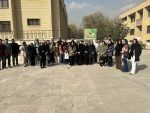
The forest research department started working since the establishment of the Forestry and Rangeland Research Institute in 1347. Due to the lack of forest and wood resources in the country, the initial research of this department was mostly focused on the adaptation studies of fast-growing non-native trees (broadleaf and conifers), which were carried out using about 330 species and different provenances in different parts of the country. Currently, with regard to the ecological regions of the country, the main view of this department is based on the ecosystem approach, in which it is necessary to first understand the nature of the forest and the natural sequence and evolution of the forest masses, and to preserve the forest in relation to the preservation of the soil and the field. . In accordance with climate change and its effects on natural ecosystems and the need to change approaches, the forest research department also conducts its research on sustainable management of forests, forestry close to nature, quantitative and qualitative monitoring of forest areas, protection of natural forest stands and wood production from Through afforestation, it has focused on degraded forest areas and other non-forest areas.
The presence of 12.4 million hectares of forest land with an average annual growth of 3 cubic meters per hectare in the north and 0.5 cubic meters per hectare in the west has made Iran one of the countries with low forest cover. However, this limited amount is facing a serious risk of destruction due to the increase in population and the expansion of villages and cities, land conversion into agricultural land, animal grazing and excessive exploitation. Therefore, achieving optimal management and increasing the quantity and quality of forest products and products has determined the necessity of basic and applied research at the level of the country’s forests.
Department news
Posts widget (DinaKala)
-
 بازدید آموزشی دانشجویان پردیس ابوریحان دانشگاه تهران از موزه حشرات باغ گیاهشناسی ملی ایران
22 November 2025
بازدید آموزشی دانشجویان پردیس ابوریحان دانشگاه تهران از موزه حشرات باغ گیاهشناسی ملی ایران
22 November 2025
-
 آیین تکریم و معارفه رئیس بخش تحقیقات گیاهان دارویی و محصولات فرعی
20 October 2025
آیین تکریم و معارفه رئیس بخش تحقیقات گیاهان دارویی و محصولات فرعی
20 October 2025
-
 ارزشیابی سالانه طرح های تحقیقاتی محور نشست بخش تحقیقات مرتع
15 October 2025
ارزشیابی سالانه طرح های تحقیقاتی محور نشست بخش تحقیقات مرتع
15 October 2025
-
 برگزاری دوره ارتقاء مهارتهای میزبانی و دانش تخصصی موزه حشرات
8 October 2025
برگزاری دوره ارتقاء مهارتهای میزبانی و دانش تخصصی موزه حشرات
8 October 2025
-
 بررسی موضوع “باغ بذر درختان جنگلی” در جلسه نخبگانی مؤسسه تحقیقات جنگلها و مراتع کشور
7 October 2025
بررسی موضوع “باغ بذر درختان جنگلی” در جلسه نخبگانی مؤسسه تحقیقات جنگلها و مراتع کشور
7 October 2025
-
 جنگلهای شمال استان کرمان و راهکارهای حفاظت و احیای آنها
15 September 2025
جنگلهای شمال استان کرمان و راهکارهای حفاظت و احیای آنها
15 September 2025
-
 نشست و بازدید میدانی اعضای هیئت علمی دانشکده بهداشت دانشگاه علوم پزشکی تهران از مؤسسه تحقیقات جنگلها و مراتع کشور
3 September 2025
نشست و بازدید میدانی اعضای هیئت علمی دانشکده بهداشت دانشگاه علوم پزشکی تهران از مؤسسه تحقیقات جنگلها و مراتع کشور
3 September 2025
-
 رئیس بخش تحقیقات مرتع: مراتع، ستون امنیت غذایی کشور و گونزارها، ستون فقرات مراتع هستند
21 August 2025
رئیس بخش تحقیقات مرتع: مراتع، ستون امنیت غذایی کشور و گونزارها، ستون فقرات مراتع هستند
21 August 2025











